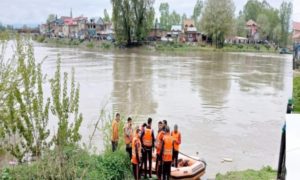Behind the current tourism façade, the unaddressed issue of fading boats is distressing Dal Lake dwellers. Part of the problem is said to be last year’s draft and decree of years — pushing the ‘anchorless’ community to obscurity now.
On the deck of his floating house, Yaqoob Duno laments over his tribe’s identity loss in the ‘water graveyard’.
Ever since the pandemic created another phase of pathos in the “world-famous Dal Lake”, it has consumed an ace swimmer and a near dozen houseboats.
Some of the iconic vessels of yore—graced by the likes of Jim Morrison and VS Naipaul during their “nirvana years” in the mountains—are reduced to a sunken glory now.
Years of gag on repairs and renovation—toothed with the last summer’s controversial draft—make Duno anxious about his water-borne community’s future.
“That draft read like a last nail in the coffin,” the worried houseboat owner says. “Even before that, efforts were being made to destroy the houseboat culture in Kashmir.”
As they remain marooned in water, houseboats need a binding bottom repairing every year. “But due to the ban, we’re not able to fix it, and are on the verge of destruction,” Duno says.
“We’ve been already struggling due to the unprecedented situation in Kashmir. To make matters worse, the government has time and again imposed draconian laws to curtail the growth of houseboat tourism in Kashmir.”
Much of this anguish stems from the Draft House Boat Policy issued on June 27, 2020 — proscribing new houseboat construction and seeking renewal of existing ones.
“Once the draft was declared,” Duno continues, “most of us knew that it was just a matter of time now.”
Living with the same fears, Duno’s tribe member, Mohammad Shafi’s sleep ended on January 6, 2021, when his New Shimla got rattled by the season’s first snowfall.
Years of restriction had rendered his houseboat base hollow. And when those early morning jolts shook him, the boatman was stunned to see seepage in his water abode. To save his family and some important documents, he sought help from his sleepy neighbours.
“I tried to block water for around three hours with my bare hands and logs,” Shafi recalls the horror hours of his life with rapt clarity. “All my clothes socked wet and my hands froze with cold icy water.”
When he couldn’t hold it further, he left his boat and stood on the wooden bridge to watch his floating home sinking in front of his eyes. Even his frenetic calls to the cops couldn’t come to his rescue.
After New Shimla—a home of ten members—wrecked in the frozen waters of Dal Lake amid snowfall, Shafi shifted his family to a small hut behind the boat.
“If today it was mine, tomorrow it would be someone else’s houseboat,” says the houseboat owner, now driving a three-wheeler to put food on the table of his family.

Within spitting distance of Shafi’s ‘sunken ship’, Bulzimer met the same fate in that snowy morning.
The houseboat owner, Mushtaq Sopori, along with his three siblings, was sleeping in a shanty behind their boat when gushing water woke him up.
“When I opened the door of my hut, I saw my houseboat tilting and sinking,” Sopori recounts his life’s devastating scene. “I called my brothers, but none of them could prevent the inevitable.”
Bulzimer was a 35-year-old houseboat, originally owned by Mushtaq Sopori’s late father, Ghulam Nabi Sopori. His sons would do small maintenance yearly, but could not fix the houseboat bottom—becoming its Achilles heel this snow-laden winter.
New Shimla and Bulzimer are among the ten houseboats to have sunken in the troubled waters of the valley in the last six months. “This much of houseboat death count was never witnessed in Kashmir before,” says Abdul Hamid Wangnoo, president of Kashmir Houseboat Owners Association (KHOA).
“Due to the blanket ban on reconstruction, repair and renovation, Kashmir’s iconic houseboats may barely survive for a decade or so, unless things won’t change for the better.”

The ban was first imposed in 1980 “to restrict the number” of floating houses — considered as the main source of pollution.
Back then, there were around 1,500 houseboats in the four water bodies: Dal Lake, Nigeen Lake, Chinar Bagh, and River Jhelum. However, the number has drastically declined to 950 today.
For tourists visiting Kashmir, staying in a houseboat for a few days and exploring Dal Lake in a Shikara is the main part of their travel package. Houseboat interiors are designed with wood-carved walls, with Kashmiri woven carpets giving a cultural touch to the whole ambience. Rooms are upgraded with high-class furniture, with the latest facilities available for tourists.
However, this mesmerising picture got distorted in March 2009, when the J&K High Court completely banned repairs and renovation of houseboats—keeping “deteriorating condition” of water bodies in view. Since then, around 200 cases seeking permission for houseboat repair are pending with the Tourism Department.
“The court has been misguided that the houseboats are the main contributor of pollution when they contribute only 3 per cent of the total sewage poured in Dal Lake,” Duno says.
“The main pollutants are the small communities living around the lake. While they go scot-free, we’re being made scapegoats.”
The government should come forward and make it clear to the houseboat owners about their real motives, says Duno, standing on his decaying deck.
“If we’re supposed to keep houseboats, then we should be allowed to repair and renovate them. But if that’s not the motive, then give us the cost of our boats and shift us to some other places.”
Free Press Kashmir is now on Telegram. Click here to Join.
FPK Android App for 2G. Click here to Download.








